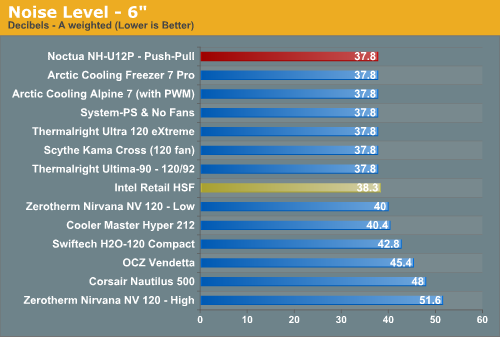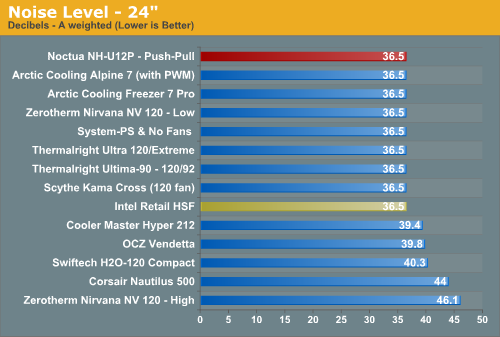Noctua NH-U12P: Top Performance AND Silence
by Wesley Fink on March 20, 2008 8:00 PM EST- Posted in
- Cases/Cooling/PSUs
Noise Levels
For many enthusiasts upgrading cooling the goal is maximum stable overclock, and they will live with the inconvenience of a louder system. For other users silence is the most important factor, and these users will forgo maximum overclocking if that increases system noise levels. Those who expect silence to be the domain of high-priced cooling solutions will find the Noctua reputation for silence continues with the NH-U12P. The performance is certainly there, but low noise is not sacrificed to reach those performance goals.


The stock Noctua NH-U12P is one of the quietest coolers we have tested so far in our new cooling test bed. This should not be a surprise as Noctua rates the cooler at 19dB(A) at the highest fan speed. All four test results are at the floor of our system noise, and the new test bed system noise floor is equivalent to a suburban bedroom at night in noise level.
When we test with the NF-P12 fan - or fans in push-pull - at their highest speed, the system remains below the noise floor with one or two fans operating. Those who want to use a fanless power supply or mount their power supply in another room can choose two even quieter configurations with the Low-Noise and Ultra-Low-Noise adapters. We did not reach noise levels higher than our variable speed Corsair 620W power supply even with two fans on high, so there is no point in trying to measure even lower and quieter speeds.
If your goal is silence, we are confident the new NF-P12 fan can meet your expectations, even if they are test results in a lab instead of real-world testing. The NH-U12P is virtually silent, even when pushed hard with push-pull fans and massive overclocking










51 Comments
View All Comments
poohbear - Monday, March 24, 2008 - link
im going on previous cpus that overclocked upto 70%, currently the wolfdales that go from 2.6 to 4ghz are'nt a 50% overclock, but still bloody impressive. My opty 165 goes from 1.8-3.0ghz, which is a 66% overclock.:)Nihility - Friday, March 21, 2008 - link
I thought the F7P had terrible build quality, at least that's what I hear from the reviews on newegg.RamarC - Saturday, March 22, 2008 - link
many newegg reviewers are idiots.i've had two f7p's for the past 14 months. problems: zero; performance: fantastic. anything that can keep a pentium d 945 in the 50s under load and not sound like a f'n jet engine is fantastic in my book. and my e6600 @ 3ghz peaks in the low 40s with the fan spinning at only 800rpm.
JarredWalton - Sunday, March 23, 2008 - link
Yeah, we pretty much http://www.anandtech.com/casecoolingpsus/showdoc.a...">found the same thing in our review. No, you're not going to match the Thermalright Ultra-120 eXtreme, but then at 1/4 the cost you can't complain too much. The F7P is substantially better than retail HSF in noise levels and performance, at a cost of http://www.ewiz.com/detail.php?p=FAN-AC7PRO">$20 shipped.Syzygies - Friday, March 21, 2008 - link
I too have a Thermalright U120E push pull, using a pair of Scythe S-FLEX SFF21F fans, in an Antec P182 case decked out with other fans. I too used cable ties: One can fashion a pair of four-sided harnesses, using four cable ties each. Size them almost to fit, trimming so there's still a bit of plastic to pull on, then gingerly tighten a click at a time to snug, for a perfect fit.Anandtech has the best air cooling reviews, period, lending much-needed credibility to any comparisons with water cooling. In contrast, another site has a water cooling review that cools a 3.2 GHz Q6600 to 58 C to 62 C at full load, comparing favorably with a Zalman 9700. Those are exactly the numbers I'm getting with my U120E, and I'm getting nowhere on that forum pointing out how cooked the review looks.
For those of us trying to wring every advantage from air, we're unlikely to use an "average" case, and we're likely to consider lapping. Besided returning the U120E to the ring in push pull mode, those are my questions.
silhrt - Friday, March 21, 2008 - link
Back on the Noise Levels page, I noticed that at 6", 7 of them were at the same and at 24", 9 of them were at the same level. Rarely, if ever, are these tests with so many the same. ( not even .1 differenece ) So, this leads me to wonder if the method of testing is accurate.Is there any way to get a sensor that reads below 30? Maybe near 20?
Since its at the low end of the sensor, maybe its bottoming out?
Wesley Fink - Friday, March 21, 2008 - link
As clearly stated in the review those noise levels are the noise floor of the test system, which is equivalent to a suburban bedroon at night. Since we are running a varaiable speed low-noise power supply and fanless video card these levels represent the quietest power supply we could find that also realistically supports overclocking. The video card is fanless and zero noise.We don't test or try to measure even lower levels because that is not the way people actually run their systems. If you are interested in the noise level of a component in isolation with a power supply in another room there are other web sites that will provide you that information.
a09805 - Friday, March 21, 2008 - link
I would not blame the sensor.I guess the problem is a higher-than-desired ambient noise. There's evidently something else in the testing room that shouts in the background, and that covers the whisper of the fans. We need a more silent environment to compare noise from a fan or two. Also, we should measure noise at about 1m, that would be a typical real-world minimum distance.
For some serious thoughts and hints about silent computing visit www.silentpcreview.com.
woofersus - Friday, March 21, 2008 - link
So when are you going to slap that fan on a the big thermalright? Best fan meets best heatsink? Could be a match made in heaven even without push-pull..Wesley Fink - Friday, March 21, 2008 - link
You read our mind - or at least the hints in the Final Words :) We'll be doing it soon.